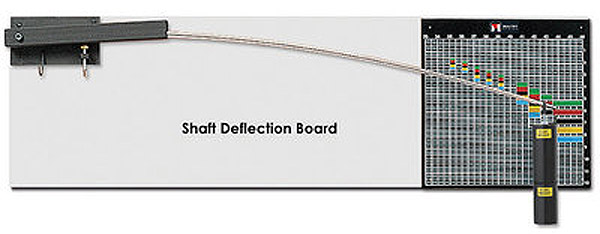Testing a Shaft for Bend (Kick) Point
Not all shafts correctly bend to an individual golfer’s needs.
Shaft properties, including flex, torque, bend point (also referred to as kick point or flex point), shaft length and weight, play important roles. These factors affect the balance and feel of golf clubs as well as ball trajectory. Particularly, graphite shafts come with a wide range of specifications. Shaft flex is probably the most important and certainly the easiest concept for the average golfer to understand. Additionally, it is the quickest and most direct way to gain improved performance from your sticks.
Shaft Flex in General
All manufacturers of golf clubs have their own standards of what constitutes the various golf shaft flexes. When testing golf shafts, there are a number of tests that can be done. These industry standard tests assure the quality, characteristics, durability and performance of a particular golf shaft. Each manufacturer has shaft flex, torque, and kick point tests that each shaft must pass. Other tests are for informational purposes only. They provide consumers with an idea of certain shaft properties like launch, spin, and feel.
There are many terms that are used to describe the stiffness of a shaft. Shafts that do not bend very easily are considered to have a stiff flex, or have high frequency (cycles per minute or CPM). Shafts that bend quite easily are considered to have a soft flex, or have low frequency. We have a Frequency Matching Analyzer to perform flex testing. A typical shaft will have a smaller diameter and thicker wall at the tip section than at the butt. The materials used, also vary along the length of the shaft. Regardless of the differences in material and wall thickness between the tip and the butt, the large change in diameter is the dominant influence in shaft stiffness. Therefore, the larger butt end is almost always stiffer than the smaller  tip end.
tip end.
Shaft Properties
Every shaft both graphite and steel has a unique set of properties that determine how the shaft performs under load and how it feels during load (down swing) and at impact. The type of shaft profiles vary greatly as manufacturers try to get a competitive advantage by designing shafts with different performance characteristics.
At a minimum, most shafts will have profiles that identify the “stiffness” in the butt section, mid section and tip section. These characteristics may also influence the trajectory (low to high) and spin rate (low to high) of the shaft. Other shaft profile measurements are based upon CPM at specific points along the shaft. Another measure, which we use, is how much force it takes to bend a shaft a particular distance at various points along the shaft.
The Significance of SHAFT BEND POINT
Bend Point is the more common term to use among kick point and flex point. For Shaft Bend Point testing, we use our own proprietary bend point testing jig. A golf shaft has only one bend point. The majority of club Manufacturers do publish their bend points of new shafts. Older shafts may not be labeled. Trimmed shafts used to customize club length may not have been tested for bend point prior to installation. We routinely perform this task when we build, repair, or retro-fit clubs.
How Bend Point is Determined
The Bend Point is determined by measuring the shaft’s maximum point of deflection. This is when it is statically bent from pressing in from the tip and butt locations of the shaft. Once the bend point location is identified, this will indicate the degree of shaft tip stiffness. If a shaft is considered to be “tip stiff” – this means it is “butt flexible”. Hence, the bend point is located closer to the butt end of the shaft than the tip. This is what is termed as a High Bend Point. On the other hand, if a shaft is thought to be “tip soft”. The bend point is located closer to the tip rather than the butt end. This is referred to as a Low Bend Point.
The Bend Point only moves a small distance in all shafts. However, the movement can dramatically change the shaft’s playing characteristics – how the club performs. When a golfer has an accelerating club head speed with a late wrist release into impact, they will usually hit better with a stiff tip shaft. Conversely, if a golfer has a decelerating club head speed coming into impact with an early wrist release, they tend to hit better with a medium or soft tip shaft. Of course, ball flight observation can confirm the necessary Bend Point.
Bend Point and Your Swing
We have several tools that profile shafts and their bend point against a benchmark cross-section of industry standards. Identification and matching of the appropriate shaft flex and bend point must fit your swing characteristics. It can make an improvement in your shot distance as well as accuracy. Bend point is best thought of as the distribution of flex throughout the shaft. It is also a function of feel. A low bend point generally works for golfers who want to feel the club head more in the swing. A mid or high bend point is usually for the golfer that wants a firm feel at impact or has strong downswing acceleration.
